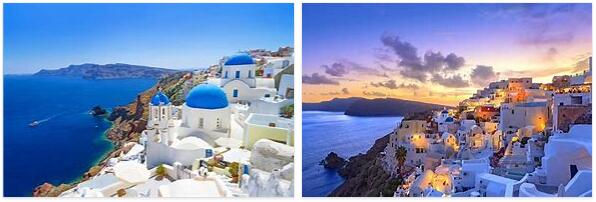Santorini, Greece

Santorini or Fira is the southernmost of the Cyclades. Its area is 76 km 2, the length of the coastline is 70 km, the population is about 8000 people.
The island is famous for its wines and beans (“fava”).
Among other products produced by the island are tomato paste and fossils – pumice and “Firs earth”.
You can fly to Santorini by plane from Athens, from Mykonos, Rhodes, and also sail by ferry from Piraeus, from Cyclades, Crete, Dodecanese and from Thessaloniki. In summer, high-speed catamarans go from Piraeus.
If you had to choose the most impressive of the many attractions in Greece, there is no doubt that one of the first would be Santorini.
So remarkable is the wild, unearthly beauty of the island, created by a volcano that burns in the middle of the bay, like a black monster that has plunged part of its body into the sea. And around the volcano lie, arched like a crescent, the remains of an island plunged into the waves. Huge multicolored rock. Black, red, grey, brown. High above, on the very edge of the cliff, peace and quiet reign, peacefully coexisting with the wild and unearthly, and lies a white crown, consisting of houses, arches, terraces and domed churches. These are Fira, Firostefani, Imerovigli and further – Oia, and on the contrary – an islet, which is the remnant of the disappeared great island – Ferasia. Here, the presence of a man who tamed the monster, came here, boldly and defiantly settled on top, is very noticeable.
What brought him here, to the very edge of the abyss – contempt for danger, admiration for the stunning landscape or the breathtaking spectacle that opens from here?
It is difficult to answer this question. Such, therefore, is the famous Santorini. There is no doubt that the trip to this island will forever remain in your memory. You will take pleasant walks through the picturesque narrow streets of Fira. Then you will visit Oia, nestled between the red rocks, by car, take a boat to the volcano, and in the evening you will have a rest, having fun as you wish. You will visit ancient Fira and the Minoan city freed from the ashes on Akrotiri.
And if you still have time, you can go down to one of the black pebble beaches – in Kamari or Perissa, to swim in the clear sea water. Or, try to go down on a small submarine into the very mouth of a dormant volcano.
The oldest population of Santorini, which appeared here around 3000 BC, was pre-Greek. The influence of Minoan Crete was established at the very beginning during excavations at Akrotiri, when a whole settlement suddenly appeared from under a powerful layer of volcanic ash with two- and three-story houses decorated with frescoes that resemble wall paintings of Minoan palaces. At the time of the existence of this settlement, the island must have been called Callista (“Most beautiful”) or Strongila (“Round”) because of its shape, since the volcano had not yet begun its destructive activity. However, around 1450 B.C. an event took place that decisively influenced the history of the ancient world. We are talking about a terrible volcanic eruption, which was located in the center of the island, as a result of which most of the island sank into the sea. Tsunami waves caused by the eruption whose height presumably reached 100 m, according to one of the many versions, they hit the northern coast of Crete and destroyed the Palace of Knossos, according to another, the earthquake was so powerful that it was enough to destroy the palace, which was located at a decent distance from Santorini. This may have led to the end of the Minoan civilization. The catastrophe was completed by strong residual earthquakes and volcanic ash thrown over a considerable distance.
From the ancient Strongyla, only the now visible crescent with a sheer cliff more than 300 m high in the western part and gentle beaches in the eastern part remained. This crescent was also covered with a layer of ash 30-40 meters thick. Eruptions, of course, not so significant, then occurred in the 3rd century BC, when Therasia separated from the island, in the 2nd century BC, when islands of volcanic origin (Palea Kameni) began to appear in the middle of the bay, up to 1928, and in 1956 a major earthquake destroyed most of Santorini’s houses. There are scientific studies trying to prove that the sunken island was the long-sought Atlantis. Despite the activity of the volcano, history did not stop on Santorini. In the XI century BC. here appeared the Dorians under the leadership of Fira, from which the island got its new name. The Dorians founded ancient Fira high in the northeastern part of the island. The name Santorini is later and comes from Santa Irini – Saint Irina, who is so revered by the inhabitants of the island. During the Peloponnesian War, Santorini sided with Sparta, and then came under the rule of the Athenians. The Venetians arrived here in 1207 under the leadership of Marco Sanudo, who included the island in the Duchy of Naxos. The Turks took possession of the island a little later than the other Cyclades (about 1570), and reunification with Greece took place in 1832.